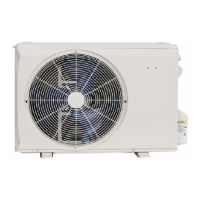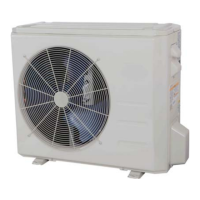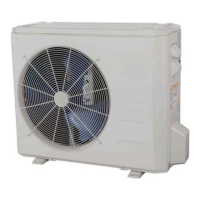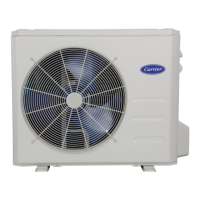Do you have a question about the Carrier 38MHRCQ12AA3 and is the answer not in the manual?
Warning about electrical shock during installation/servicing.
Warning about explosion risk from oxygen mixtures.
Caution regarding improper installation affecting equipment.
Guidelines for unit spacing in multi-unit configurations.
Details how to connect power and communication wires.
Provides guidelines for selecting appropriate refrigerant lines.
Specific instructions for systems with extended refrigerant lines.
Explains the deep vacuum procedure for system evacuation.
Describes the triple evacuation method for moisture removal.
Lists abbreviations for sensors and parameters.
Details the unit's primary protection mechanisms.
Describes how the unit operates in different modes.
Describes how to manually initiate or exit defrost mode.
Essential safety warnings before troubleshooting.
Solutions for EEPROM parameter errors.
Troubleshooting for communication errors between units.
Steps to resolve zero crossing detection errors.
Troubleshooting for indoor fan speed issues.
Diagnosing DC fan motor issues for indoor/outdoor units.
Resolving temperature sensor circuit faults.
Steps to diagnose and fix refrigerant leaks.
Troubleshooting overload current protection issues.
Diagnosing IPM/IGBT malfunction and over-current protection.
Troubleshooting over/under voltage protection.
Steps to resolve compressor high-temperature protection.
Diagnosing inverter compressor drive errors.
Procedures for checking main components like sensors.
Procedure to check compressor winding resistance.
Method to check IPM continuity.
Procedure to measure fan motor winding resistance.
Temperature sensor resistance values for T1, T2, T3, T4.
Warning about electrical shock during installation/servicing.
Warning about explosion risk from oxygen mixtures.
Caution regarding improper installation affecting equipment.
Guidelines for unit spacing in multi-unit configurations.
Details how to connect power and communication wires.
Provides guidelines for selecting appropriate refrigerant lines.
Specific instructions for systems with extended refrigerant lines.
Explains the deep vacuum procedure for system evacuation.
Describes the triple evacuation method for moisture removal.
Lists abbreviations for sensors and parameters.
Details the unit's primary protection mechanisms.
Describes how the unit operates in different modes.
Describes how to manually initiate or exit defrost mode.
Essential safety warnings before troubleshooting.
Solutions for EEPROM parameter errors.
Troubleshooting for communication errors between units.
Steps to resolve zero crossing detection errors.
Troubleshooting for indoor fan speed issues.
Diagnosing DC fan motor issues for indoor/outdoor units.
Resolving temperature sensor circuit faults.
Steps to diagnose and fix refrigerant leaks.
Troubleshooting overload current protection issues.
Diagnosing IPM/IGBT malfunction and over-current protection.
Troubleshooting over/under voltage protection.
Steps to resolve compressor high-temperature protection.
Diagnosing inverter compressor drive errors.
Procedures for checking main components like sensors.
Procedure to check compressor winding resistance.
Method to check IPM continuity.
Procedure to measure fan motor winding resistance.
Temperature sensor resistance values for T1, T2, T3, T4.
| Brand | Carrier |
|---|---|
| Model | 38MHRCQ12AA3 |
| Category | Air Conditioner |
| Language | English |












